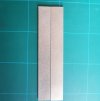He's a good shot of the effectiveness of BKF. These are 3 EZE-Lap diamond slip stones I use in machine shop work. They are in varying levels of wear. The left most one is quite worn out, the middle is fairly worn and the right side one is fairly new. You can see the difference in swarf build-up pretty clearly in the before photo. The left two are worn enough to be quite fine, so they don't collect as much steel. The right one is quite aggressive still since it's still new and it collects quite a lot of swarf as you can see by the embedded black steel.

Apply BKF paste. Wait for 5 minutes.

Scrub with a plastic dish scrubber sponge and rinse thoroughly. Et voila, hones are free of embedded steel.


Apply BKF paste. Wait for 5 minutes.

Scrub with a plastic dish scrubber sponge and rinse thoroughly. Et voila, hones are free of embedded steel.











